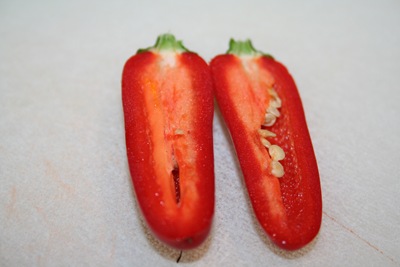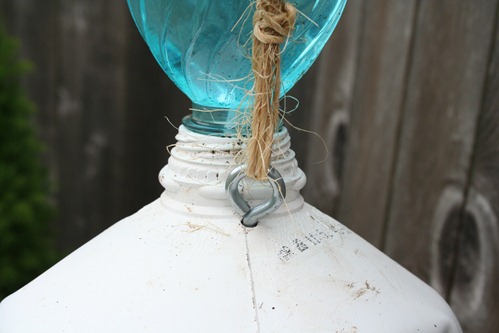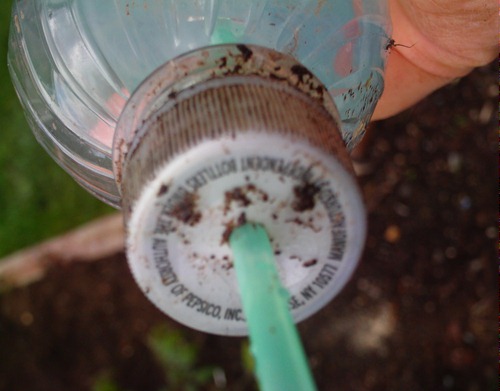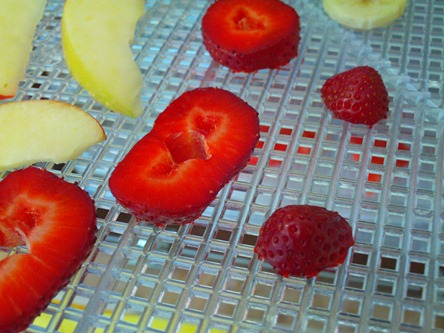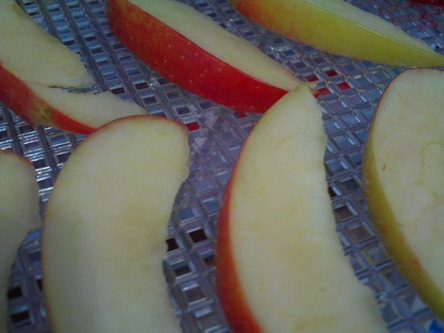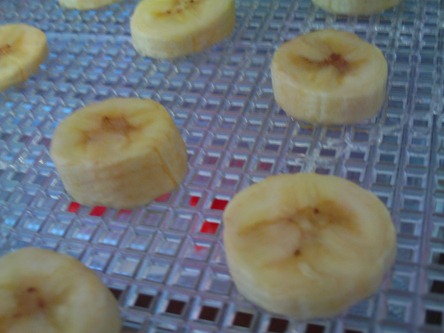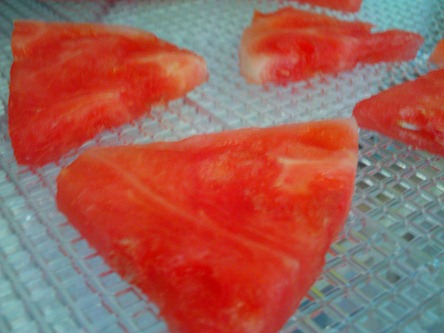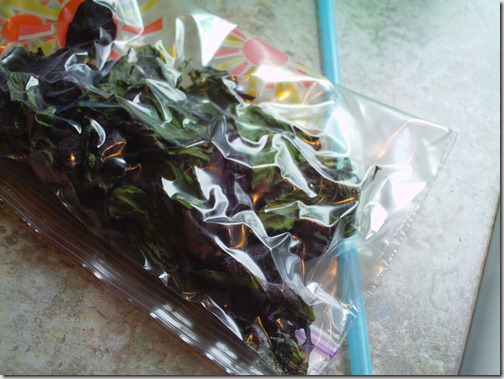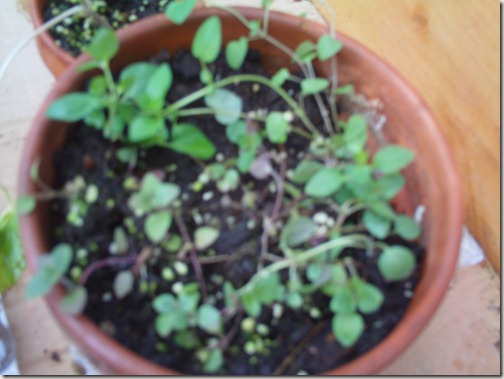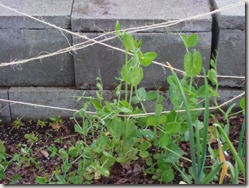How to save jalapeno seeds
9.7 years ago jalapeno, peppers, seed saving
I am attempting to grow the best pepper plants I can indoors (grow box) so I started with jalapeno peppers. They grow relatively small 2-3 feet and require 2-3 gallon container for growing. While this is fine for an outdoor garden, though indoors I can only sacrifice 1 gallon container. This summer I grew several jalapeno plants which spent half of their life in the grow box and spent our warm summer outdoors. All of the plants produced but there was definitely a clear winner which had incredible early yields even with its small growing quarters.
I used several immature peppers (green) for salsa this year but allowed several peppers to mature (red) which I will be saving the seeds for planting this winter and next summer for future plants. By hand selecting the best parent plants should be good old natural selection at work.
The process to collect pepper seeds is pretty simple though I must first provide this warning:
WARNING: Peppers are hot, especially the veins. When handling peppers use caution and wash your hands well with dish soap. Under no conditions do not rub your eyes or pick rub your nose before washing your hands or you will be regretting it for a couple hours. Using gloves is also recommended.
That being said slice the peppers lengthwise with a sharp knife.
Use a fork or spoon to gently dislodge the seeds into a small bowl.
If you are lucky enough to have hot sunny weather still (week of rain here) lay they out in the sun for a couple days and store them in a cool dry place until you are ready to plant them. If you are sun challenged like me set them on a windowsill for a few days.
As I have said before saving you own seeds is very easy and free and as an added bonus you can personally pick the best plant to be the donors of seeds for your future plantings. In my case I also have the benefit of a plants that is genetically grown to following my sporadic watering and care patterns.
Tags: garden seeds, growbox, outdoor plants, pepper plants, salsa garden
How to make your own upside Down Planter In your Garden
13.9 years ago garden planter, planter, upside down planter
Over the past year I have created a few different versions of garden planters for growing tomatoes, peppers, cucumbers inspired from my daughter watching a Topsy Turvy tomato planter commercial. Here is a quick summary of the different options which you can click the link for full instructions how to build on yourself.
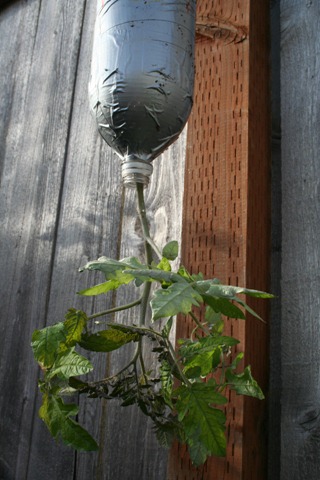 |
2 Liter – The Original — This is the one that started it all. Very simple design using a 2 liter bottle covered with duct tape with a hole cut in the side to add soil and water as needed.Pros: Simple to create, dark color helped keep soil warm during the early part of the year, unlike the sibling seedling which I planted in the ground as a control which did not make it.Cons: Really had to keep up on watering, given it had a 2 inch hole in the side water was able to easily evaporate and it did not get the advantage of being watered automatically on raining days/weeks and given I wasn’t watering any other plants forgot about this poor one which led to reduced yields. |
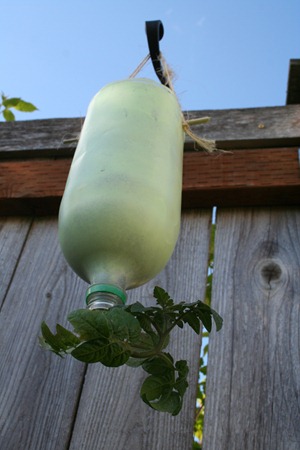 |
2 liter — Version 2.0 — This year I wanted something that did not appear as hideous hanging and also took care of the watering issue from the previous version. With this I created a slow drip watering reservoir and used spray paint and skipped the duct tape.Pros: Easy to water through manual or automatic (rain), evaporation is minimized due to small drainage holesCons: At the moment, there are none known. I am happy with this design. |
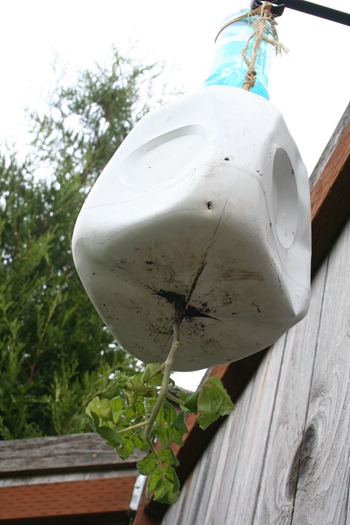 |
1 gallon milk jug (with auto-watering) — I was curious about if the extra 1.799 liters with a larger contain would significantly help yields so I went with this version. Also decided to add an experimental external watering source.Pros: Larger volume of soil, extra watering capacityCons: Keeping the whole thing balanced was a pain, currently have it under control with a couple rubber band but will probably have to be replaced with something more permanent later. |
So there you have the short evolution of my homemade upside down tomato planters all created from materials from my recycling bin. Though if you do not want to make one yourself here are a just a few of the commercial upside down planter versions on the market right now.
Tags: cheap, garden seeds, led, outdoor plants, pepper plants, tomato plants, upside down tomato planter, vegetables
1 Gallon Milk carton upside down tomato planter
14 years ago cheap, peppers, tomato, upside down planter, water
I wanted to see if (how much) my yields varied by allowing more volume of dirt in my homemade tomato planter, so I made this variation with the same type and size “Husky Cherry” seedling I am using in my 2-liter planter version.
The build for this one is also very simple:
- I started with an organic milk carton given it was already opaque, but if you have the non-organic variety you will want to paint or cover the outside with duct tape.
- Next cut or drill a 1/2 inch hole on the bottom of the milk carton, this will be where the stem of the plant will fit through.
- Cut four slits out from the center of the 1/2 inch hole to make it easier to insert the plant into the planter.
- Insert plant through the bottom.
- Fill with soil (mix of 1 part peat moss/coconut coir)
- Finally drill a hole and feed though eyelet secured with a nut from the back side
Now here is where you can stop or you can go with the advanced auto-watering option.
Materials Needed:
- 20 ounce water bottle
- plastic straw
- sponge
Build Instructions:
- Drill hole just large enough to barely be able to pull the straw through
- Cut a 1 inch long piece of sponge just wide enough to be able to slip inside the straw.
- Fill with water and screw on cap and insert into top of planter
As the dirt dries it will also dry out the sponge which will release water and repeat as necessary. This works in a very similar concept as a Aqua Globe you may have seen advertised on TV.
Tags: cheap, garden seeds, organic vegetables, outdoor plants, tomato plants, upside down tomato planter, vegetables
More Fun with Food Dehydrator
14 years ago dehydrator, herbs, strawberries
I decided to be adventurous with the food dehydrator and grabbed some stuff from the refrigerator to make some nice nutritional snacks.
I started with some strawberries, the process is very simple, take some strawberries slice about 1/4 inch thick and place on the tray.
Next I moved on to apples which I soaked in a solution of lemon juice (about 1/4 cup) with 1 cup of water. To add a little extra sweetness I also dumped in a packet of artificial sweetener to reduce the sourness from lemon. After letting the apples soak in this solution for about 3 minutes I added them to the tray.
After slicing bananas about 1/4 inch thick I also soaked these in the same lemonade bath I did for the apples for 3 minutes as well.
Finally I spliced some watermelon at the same approximately 1/4 inch thickness while removing as many seeds as possible and then placing the slices on the trays and moving them into the dehydrator preheated at 100 degrees F.
After about 24 hours the apples were ready and very delicious, these did not last wrong. Next came the strawberries which tasted ok, but were very difficult and basically not worth the time to attempt to wedge from tray and eventually gave up a through most of these away. This was followed by the watermelon which wasn’t quite as messy and tasted like semisweet candy with a light watermelon flavor which seems about right since watermelon does not have nearly as strong a flavor naturally as you would get in artificially sweetened gum or candy. Lastly were the banana chips which were good and were all eaten though for the long time required to dry I probably will opt to buy the non-fried version of these at the store.
Overall it was fun to make these but apples will probably be the only ones in a future rotation but looking forward to drying some garlic, onions, and herbs later this year.
Tags: cheap, garden seeds, garlic bulbs, herb garden, strawberry plants, vegetables
Drying peppermint leaves
14 years ago dehydrator, herbs, peppermint
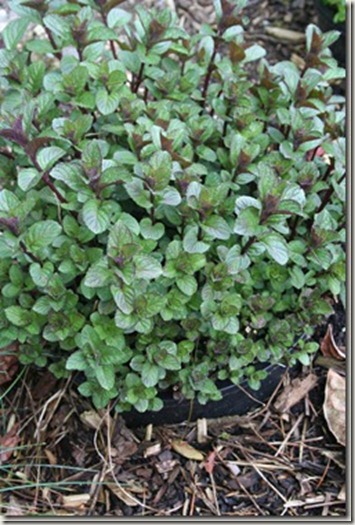
Excited to try out my new to me food dehydrator, I collected some peppermint leaves from my 2 year old peppermint plants which is fighting the confirms of the 1 gallon pot I have used to keep it from consuming my entire flowerbed, lawn, house, etc.
For the best potency, it is best to collect mint right before they start to flower and first thing in the morning when their oils are at their peak. Given it is a couple months before they will be flowering I picked them in the early afternoon.
If they were dirty you should wash them off and pat them dry with a paper towel and add directly to your dehydrator. In my case we had a rain the night before and they were very clean so I skipped the washing step.
Next I simply put them into the dehydrator at 100F degree and in a few hours later they were all crumbly and looked like what you see below.
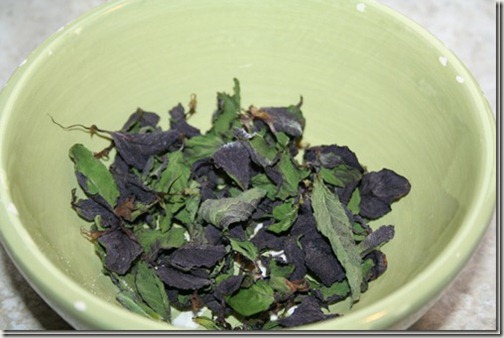
To store the leaves I went with the poor man’s vacuum packing technique…Ziploc bag and sucking the air out with a straw which should keep the herbs fresh for a few months.
Lastly I tried out the product by taking a pinch of the leaves and quickly breaking them up with my fingers and added them to a tea strainer.
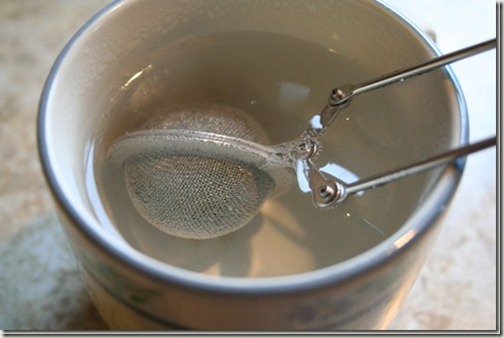
After a few minutes of steeping I had some good looking and tasting peppermint tea.
I would say my testing of my new dehydrator was a success…now off to see what else in the fridge I can dry out.
Tags: cheap, garden seeds, herb garden, outdoor plants, pepper plants, peppermint plant, vegetables
Earth Day in the garden
14 years ago cilantro, cold season crops, garlic bulbs, onions, peppers, tomato
I decided to take the day off to catch up on some things at home and as I ended up outside of course I went right to the garden.
We have seen a few warm days here in the Northwest and in my area we haven’t dipped under 40 degrees at night so seemed like a good time to plant a few of my tomatoes spending their time this winter in the grow box.
Above are a New Yorker and Persey both of which are new for me this year. They have been growing great even with my neglect during their youth. I also have some Green Zebras, Husky Cherry, Sweetie Cherry, and Yellow Cherry. I did attempt Red Brandywine but the seeds I got appear to be duds.
Given it is always good to have a Plan B so I have twins of these tomato plants still in puts which I can bring if a cold snap comes and kills off the plants I ambitiously planted in the ground.
Elsewhere in the garden I have some herbs: Parsley and Oregano, with Basil being an unfortunately casualty which I will plan on buying from the store and try again next year.
Next I checked out my larger garden bed to see my peas, cilantro, onions, carrots, lettuce, strawberries and garlic
Lastly I checked out the peppers in the grow box which they will stay until we have some warmer nights (at least 50 degrees) otherwise can cause significant stunting of growth. So until then they will remain happy in the grow box and given they are still pretty small, still plenty of room to grow…
Tags: cheap, cilantro, garden seeds, garlic bulbs, growbox, herb garden, outdoor plants, pepper plants, strawberry plants, tomato plants, vegetables

